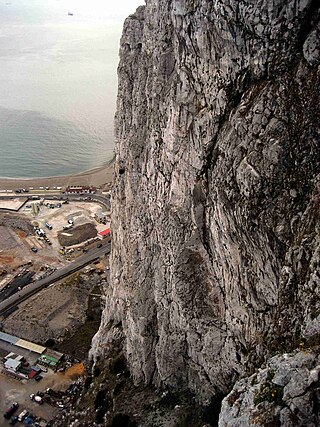
Ringstead Bay, with the small village of Ringstead at the eastern end and the prominent headland of White Nothe at the western end, is located on the coast in Dorset, southern England. The area lies on the Jurassic Coast and is known for its natural environment and fossils.

White Nothe is a chalk headland on the English Channel coast at the eastern end of Ringstead Bay, east of Weymouth in Dorset, England. The area is well known for its geology and fossils. Its flanks are the result of prehistoric landslides and the inaccessible slopes of the undercliff provide a secluded wildlife habitat.

Ringstead is a small seaside village located on the coast in Dorset, southern England. The area lies on the Jurassic Coast and is known for its natural environment and fossils. Ringstead Bay and White Nothe are to the east. Bran Point and Osmington Mills are to the west.

Bran Point is a small headland on the Dorset coast in southern England, about halfway between the small villages of Ringstead to the east and Osmington Mills to the west. There is a picturesque cliff-top path between the two villages via Bran Point.
The Ulan Malgait Formation is a Late Jurassic geologic formation in Mongolia. Dinosaur remains are among the fossils that have been recovered from the formation, although as of 2004 none have yet been referred to a specific genus.

The Valtos Sandstone Formation is a Middle Jurassic (Bathonian) formation found in the Inner Hebrides of Scotland. It is the thickest member of the Great Estuarine Group. The lithology consists of sets of approximately 6 metre thick cross bedded sandstone, capped by thin shelly limestones containing bivalves of the genus Neomiodon Dinosaur remains are among the fossils that have been recovered from the formation, although none have yet been referred to a specific genus.
The Briones Formation is a Late/Upper Miocene epoch geologic formation of the East Bay region in the San Francisco Bay Area, California.

Gibraltar Limestone consists of greyish-white or pale-gray compact, and sometime finely crystalline, medium to thick bedded limestones and dolomites that locally contain chert seams. This formation comprises about three quarters of the Rock of Gibraltar near the southernmost tip of the Iberian peninsula. Geologists have found various poorly preserved and badly eroded and rolled marine fossils within it. The fossils found in the Gibraltar Limestone include various brachiopods, corals, echinoid fragments, gastropods, pelecypods, and stromatolites. These fossils indicate an Early Jurassic age for the deposition of the Gibraltar Limestone.
The Stanford Formation is a geologic formation in England. It preserves fossils dating back to the Oxfordian stage of the Middle Jurassic period, around 160 million years ago.

The Osgodby Formation is a geologic formation in England. It comprises rocks and fossils dating from the Callovian age of the Jurassic period.
The Fullers Earth Formation is a geological formation that outcrops in southern England. It is also mostly present in the subsurface of the Wessex Basin and offshore in the English Channel Basin, Celtic Sea Basin and St George's Channel Basin. It preserves fossils dating back to the Bathonian stage of the Middle Jurassic series such as the pterosaur Dolicorhamphus. It is the lateral equivalent of the Rutland Formation, Sharp's Hill Formation, Calcaire d’Ecouché, and Calcaire de Caen
The Kingston Formation is a geologic formation in England. It preserves fossils dating back to the Jurassic period.
The Calcareous Grit is a geologic formation in England. It preserves fossils dating back to the Jurassic period.
The Ancholme Group is a geologic group in England. It preserves fossils dating back to the Jurassic period. It has previously been referred to as the Ancholme Clay Group. The group consists of predominantly grey, marine mudstone and silty mudstone with beds of argillaceous limestone nodules. In parts of its range it interfingers with the Corallian Group, which predominantly consists of coralliferous limestones.
The Cromer Knoll Group is a geological group of Early Cretaceous age, found at outcrop in eastern England and developed extensively beneath the North Sea in the UK, Norwegian and Danish sectors and in the Norwegian Sea. It preserves fossils dating back to the Early Cretaceous period.
The Staffin Bay Formation is a geologic formation in Scotland. It preserves fossils dating back to the Callovian of the Middle Jurassic. It consists of two members, the lower Upper Ostrea Member, which consists of dark grey, fissile mudstone with a shelly limestone bed, and laminated and rippled sandstones. While the upper Belemnite Sands Member consists of medium-grained calcareous sandstones and siltstones
The Coral Rag de Trouville is a geologic formation in France. It preserves fossils dating back to the Jurassic period.

West Ringstead is a deserted medieval village located on the coast in Dorset, southern England. The village lies on the Jurassic Coast and is located west of the modern village of Ringstead.

Burning Cliff is a cliff under the White Nothe headland at the eastern end of Ringstead Bay, in Dorset, England. The area is well known for its geology and fossils.









